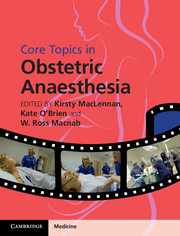Book contents
- Frontmatter
- Contents
- List of contributors
- Preface
- Section 1 Basic science, epidemiology and service organization
- Section 2 Obstetric aspects
- Section 3 Provision of anaesthesia
- Section 4 Medical conditions in pregnancy
- 14 Hypertension in pregnancy, pre-eclampsia and eclampsia
- 15 Sepsis and influenza in pregnancy
- 16 Cardiac disease in pregnancy
- 17 Respiratory disease in pregnancy
- 18 Obesity and ultrasonography for central neuraxial blocks
- 19 Endocrine disease in pregnancy including diabetes mellitus, thyroid and adrenal disease
- 20 Renal disease
- 21 Haematologic disease in pregnancy
- 22 Neurosurgical and neurological disease in pregnancy
- 23 Immunology, including testing and management of allergy during pregnancy
- 24 HIV and infectious disease in pregnancy, including herpes, syphilis and hepatitis
- Section 5 Postpartum complications and obstetric emergencies
- Section 6 Service organization
- Index
- Plate section
- References
22 - Neurosurgical and neurological disease in pregnancy
from Section 4 - Medical conditions in pregnancy
Published online by Cambridge University Press: 05 December 2015
- Frontmatter
- Contents
- List of contributors
- Preface
- Section 1 Basic science, epidemiology and service organization
- Section 2 Obstetric aspects
- Section 3 Provision of anaesthesia
- Section 4 Medical conditions in pregnancy
- 14 Hypertension in pregnancy, pre-eclampsia and eclampsia
- 15 Sepsis and influenza in pregnancy
- 16 Cardiac disease in pregnancy
- 17 Respiratory disease in pregnancy
- 18 Obesity and ultrasonography for central neuraxial blocks
- 19 Endocrine disease in pregnancy including diabetes mellitus, thyroid and adrenal disease
- 20 Renal disease
- 21 Haematologic disease in pregnancy
- 22 Neurosurgical and neurological disease in pregnancy
- 23 Immunology, including testing and management of allergy during pregnancy
- 24 HIV and infectious disease in pregnancy, including herpes, syphilis and hepatitis
- Section 5 Postpartum complications and obstetric emergencies
- Section 6 Service organization
- Index
- Plate section
- References
Summary
Neurological disease in parturient prompts the anaesthetic and obstetric team to consider many aspects of care delivery. Pre-existing conditions may progress to cause significant compromise and the onset of new neurological symptoms may mimic more commonly encountered conditions, such as PET.
Even the presence of stable neurological conditions, of the spinal cord, neuro-axial skeleton or intracranium, may require careful consideration with respect to analgesia, anaesthesia and mode of delivery.
Quantification of anaesthetic risk is essential. A major anaesthetic concern relates to the safety of performing neuraxial blockade. The following questions arise:
• Is there risk of ‘coning?’ If a CSF leak results in a discrepancy in pressure within the cranium and infra foramen magnum (cranial: spinal CSF pressure gradient CSFCr:CSFSp), cerebellar tonsillar herniation can occur caudally with brain stem compression (coning).
• Is there risk of local trauma and neurological injury? Abnormal anatomy can result in spinal cord, cauda equina or spinal nerve trauma following needling of the perispinal region.
• Is there risk of spinal haemorrhage? Neuraxial vascular abnormalities can increase the risk of bleeding as a result of needling the spinal canal.
• Will the block work? Anatomical abnormalities can impede local anaesthetic spread.
General anaesthesia in parturients with neurosurgical pathologies is not without risks. Cardiovascular fluctuations during induction of anaesthesia can precipitate brain swelling or intracranial haemorrhage. Optimization of intracranial pressure (ICP), cerebral perfusion pressure (CPP) and cerebral blood flow (CBF) is essential. It is important, when evaluating known or perceived risk of complications of neuraxial blockade, to consider the risks of not performing the block or proceeding to general anaesthesia (see Chapter 11).
Neurosurgical issues relevant to pregnancy
See Chapter 17 for spinal abnormalities.
Intracranial mass lesions
Mass lesions can be caused by infection, tumour, vascular abnormalities, inflammation (e.g. MS), cystic lesions or haemorrhage. Presentation depends upon lesion size, rate of enlargement, aetiology and location, and includes:
• Asymptomatic; identified during investigation of other pathology
• Focal neurological deficit
• Ataxia
• Global reduction in cerebral function
• Headache classically worse when supine
• Nausea and vomiting
• Seizures.
Mass effect can cause disruption of neurological function by compression or destruction of brain tissue, causing oedema within the brain, causing hydrocephalus by obstructing CSF flow and by reducing cerebral compliance, thus increasing ICP and reducing CBF.
- Type
- Chapter
- Information
- Core Topics in Obstetric Anaesthesia , pp. 165 - 175Publisher: Cambridge University PressPrint publication year: 2015



